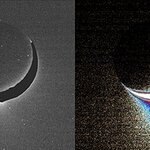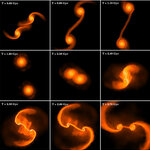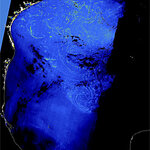Space

Since the discovery of an Earth-like planet around Gliese 581 20 light years away in the constellation Libra, the topic of a new home has generated a lot of excitement.
Bruce Fegley, Jr., Ph.D., professor of earth and planetary sciences in Arts & Sciences at Washington University in St. Louis, has worked on computer models that can provide hints to what comprises the atmosphere of a planet like that and better-known celestial bodies in our own solar system.
“The farther out you go in the solar system, the more water you find,” said Fegley.
New computer models, from both Earth-based…
NASA's Hubble Space Telescope has teamed up with the W.M. Keck Observatory to precisely measure the mass of Eris, the largest member of a new class of dwarf planets in our solar system. Eris is 1.27 times the mass of Pluto, formerly the largest member of the Kuiper Belt of icy objects beyond Neptune.
Hubble observations in 2006 showed that Eris is slightly physically larger than Pluto. But the mass could only be calculated by observing the orbital motion of the moon Dysnomia around Eris. Multiple images of Dysnomia's movement along its orbit were taken by Hubble and Keck.
Astronomer Mike…

Electrically charged gas in the magnetosphere of Saturn suggests volcanic activity on two of its moons. The direction of the ejected electrons points back towards Tethys and Dione. Previously it had been thought only only Enceladus was an active world.
CLICK ABOVE FOR FULL SIZE. Plumes of icy material extend above the southern polar region of Saturn's moon Enceladus, as imaged by the Cassini spacecraft in January 2005. The monochrome view is presented along with a colour-coded image on the right. The view in this image is perpendicular to the tiger stripe fractures that straddle the south…
A unique discovery of two celestial explosions at exactly the same position in the sky has led astronomers to suggest they have witnessed the death of one of the most massive stars that can exist.
A global collaboration of astronomers, led by Queen’s University Belfast teamed up with Japanese supernova hunter Koichi Itagaki to report an amazing new discovery. This is the first time such a double explosion has been observed and challenges our understanding of star-deaths.
Credit (c) Frederic Durillon - www.animea.com, Courtesy Service d'Astrophysique/CEA
In 2004 Koichi Itagaki discovered an…
A young star’s strange elliptical ring of dust likely heralds the presence of an undiscovered Neptune-sized planet, says a University of Rochester astronomer
Stars in the early stages of life are surrounded by dust clouds that thin out and dissipate as the star reaches maturity, becoming rings in their final stages. One star, however, has a dust ring that has long puzzled astronomers because it is not centered around the star as usual. Instead, the ring is elliptical, with the parent star off to one side.
Hubble image of Fomalhaut and ring. Credit: NASA
“We wanted to know why this ring was…
Using a robotic telescope at the ESO La Silla Observatory, astronomers have for the first time measured the velocity of the explosions known as gamma-ray bursts. The material is travelling at the extraordinary speed of more than 99.999% of the velocity of light, the maximum speed limit in the Universe.
"With the development of fast-slewing ground-based telescopes such as the 0.6-m REM telescope at ESO La Silla, we can now study in great detail the very first moments following these cosmic catastrophes," says Emilio Molinari, leader of the team that made the discovery.
Gamma-ray bursts (GRBs…

The Milky Way's total mass is about 100 billion solar masses - enormous to us but average among galaxies. It spirals around a black hole that is about three million solar masses, say cosmologists.
Imagine it meeting an identical twin. Were they to merge they would produce a galaxy that's even greater. Cosmologists think that's how galaxies grow; through a complex process of continuous mergers.
CLICK ABOVE FOR FULL SIZE. Composite black hole. Credit: Standford.
Using supercomputers to simulate galaxy mergers, scientists at Stanford and elsewhere have seen the formation of a new type of…

Sargassum seaweed, famous in nautical lore for entangling ships in its dense floating vegetation, has been detected from space for the first time thanks to an instrument aboard ESA’s environmental satellite, Envisat. The ability to monitor Sargassum globally will allow researchers to understand better the primary productivity of the ocean and better predict climate change.
CLICK ABOVE FOR FULL SIZE. Sargassum seaweed has been detected from space for the first time using optical radiance data from the Medium Resolution Imaging Spectrometer (MERIS) aboard Envisat. The ability to monitor…
University of Colorado researchers will scan Venus during a spacecraft flyby this week using an $8.7 million instrument they designed and built for NASA's MESSENGER Mission, launched in 2004 and speeding toward Mercury.
Built by CU-Boulder's Laboratory for Atmospheric and Space Physics, the instrument will make measurements of the thick clouds and shrouded surface of Venus during the June 5th flyby, said LASP Senior Research Associate William McClintock, a mission co-investigator who led the CU-Boulder instrument development team.
An artists rendition of NASA's MESSENGER spacecraft, which…

The Huygens Atmosphere Structure Instrument (HASI) scored a first in 2005 by measuring the electrical conductivity of Titan’s atmosphere. The results hint at a new way to investigate the subsurface layers of Titan and could provide insight into whether or not Titan has a subsurface ocean.
The Permittivity, Waves and Altimetry (PWA) sensor on Huygens detected an extremely low frequency (ELF) radio wave during the descent. It was oscillating very slowly for a radio wave, just 36 times a second, and increased slightly in frequency as the probe reached lower altitudes.
CLICK ABOVE FOR FULL SIZE…